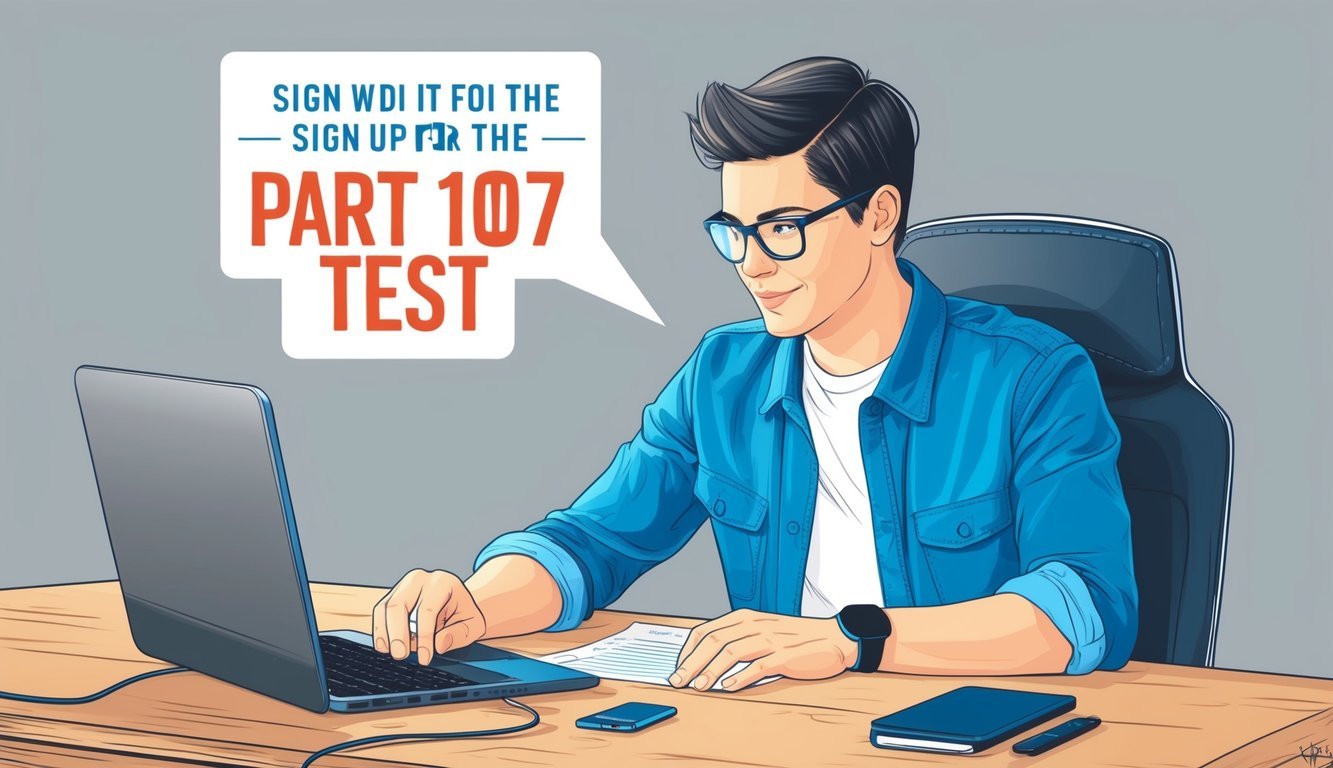Getting your drone pilot license might seem daunting at first, but trust me, it’s not as tough as you might imagine.
The key to flying drones commercially in the U.S. is passing the Part 107 test. To sign up, you’ll need to snag an FAA Tracking Number (FTN) and schedule your exam through PSI, the testing company.
alt=”A person filling out paperwork at a desk with a computer, books, and aviation materials”>
It all starts with getting familiar with the rules.
The Federal Aviation Administration (FAA) has set guidelines that every drone pilot needs to know.
Once you’ve got a grip on these, you can dive into the next steps with confidence.
Preparing for the test does take some effort, but it’s absolutely worth it.
The Unmanned Aircraft General exam touches on essential topics like airspace rules and weather conditions.
With a bit of study time, you’ll be all set to ace that test and launch your drone pilot career!
Key Takeaways
- Start by obtaining your FAA Tracking Number; that’s your first step toward the Part 107 test.
- The exam costs $175 and covers key topics such as airspace rules and weather.
- Passing it means you can fly drones for commercial purposes in the United States.
Preparing for the Part 107 Knowledge Test
Getting ready for the Part 107 test involves several steps.
You’ll need to meet specific requirements and use the right study materials, and it helps to get your registration right.
Here’s what you need to know to prep effectively.
Understanding the Requirements
First up, you need to be at least 16 years old and be able to read, write, and speak English.
The FAA requires you to have a government-issued photo ID as well.
Before you sit for the test, grab your FAA Tracking Number (FTN).
Think of it as your unique ID card for the FAA—it helps them keep track of your records.
You can snag an FTN by creating an account on the Integrated Airman Certification and Rating Application (IACRA) website.
The test itself dives into topics like:
• Drone regulations
• Airspace classification
• Weather
• Drone operation
Study and Training Resources
The FAA provides free study materials for the Part 107 test, including a Remote Pilot Study Guide and sample questions that can be super useful.
Lots of folks find these helpful for the basics.
If you want deeper insights, think about a training course.
These often cover things like:
• Sectional charts
• Weather patterns
• Flight rules
Taking practice tests is an awesome way to familiarize yourself with the format and pinpoint any areas that need a bit more focus.
And let’s not forget about hands-on practice—frequently flying your drone reinforces what you’re learning.
Just like muscle memory, you want it to feel second nature!
Registering with IACRA
IACRA is the FAA’s online system for pilot certification.
Here’s your quick guide to register:
- Head over to the IACRA website.
- Create your account.
- Fill out Form 8710-13.
Make sure to have your FTN handy while filling out that form.
And remember, double-check your details before hitting submit—it can save you a headache later on.
After you pass your test, you’ll return to IACRA to apply for your remote pilot certificate.
Keep an eye on the system; it should update your test results within 48 hours.
Just a heads up, IACRA can be a bit tricky, so take your time and follow each step carefully.
Taking the Test
Preparing for the Part 107 test involves a few key steps.
You’ll want to schedule your exam, prep for test day, and know the next moves once you’ve completed it.
Here’s the lowdown.
Scheduling Your Exam
Ready to schedule your FAA Part 107 exam? Get your FAA Tracking Number (FTN) first.
After that, create a free account with PSI, the company that manages the testing centers.
They’ll handle everything from booking to payment for the Unmanned Aircraft General – Small exam.
The fee is $175, and you can choose a date, time, and testing center that works for you directly from PSI’s site.
Pro tip: Book early to snag your preferred time!
Before you hit that schedule button, make sure you meet the FAA’s Remote Pilot Certificate requirements—16 years old and able to read, write, and understand English.
On the Day of the Exam
When test day rolls around, be prepared! Bring your government-issued photo ID and aim to arrive early at the testing center.
The staff will check you in and guide you through the process.
The test consists of 60 multiple-choice questions, and you’ve got 2 hours to finish it.
Unfortunately, you can’t bring any study materials, but they’ll provide scratch paper and basic tools like a calculator—thank goodness!
Stay calm and read each question carefully.
If something trips you up, mark it and come back later.
Just remember, you need at least a 70% to pass.
After the Knowledge Test
Once you’ve wrapped up, you’ll get your results immediately.
If you pass, congratulations! You’ll receive an Airman Knowledge Testing Report (AKTR), which is a ticket to your next step.
With your AKTR in hand, jump over to the IACRA website to apply for your Remote Pilot Certificate.
You’ll enter your 17-digit Knowledge Test Exam ID in the process.
It might take a day or two for your results to appear in the system.
After that, it’s just a waiting game for the TSA to perform a background check.
Once cleared, you’ll get your temporary certificate via email, and your permanent one will arrive in the mail later.
Frequently Asked Questions

Preparing for the Part 107 test can bring up a lot of questions.
Here are answers to some common ones about registration, costs, test locations, and study tips.
What’s the process to register for the Part 107 drone certification exam?
First things first—you’ll need your FAA Tracking Number (FTN).
Head to the IACRA website to create an account.
Then, make an account with PSI, the testing company.
From there, you can pick a date and location for your test while paying the fee.
Is it possible to take the Part 107 exam from home?
Nope! The Part 107 test needs to be taken at an approved testing center in person.
This helps keep the test secure and fair for everyone involved.
What’s the price tag on the Part 107 exam?
The Part 107 exam will set you back $175.
You’ll pay this fee when you schedule your test through PSI’s website.
Just a heads-up—make sure you’re ready before you pay since there are no refunds if you end up needing to reschedule!
What should I bring to the Part 107 test center?
Bring along a valid government-issued photo ID—this could be your driver’s license, passport, or even a military ID.
If you think you might need a calculator, feel free to bring a basic one, but no phones or study materials are allowed inside.
They’ll give you scratch paper and a pencil.
Arriving early helps too, giving you time for check-in.
If you’ve got questions about signing up for permit test appointments, your local DMV website is a good resource.
Being prepared will help ensure a smoother testing experience.
How can I find a Part 107 testing center close to me?
PSI’s website is your go-to for searching test centers nearby.
Just plug in your zip code or city when you’re setting up your test, and you’ll see a list of convenient options.
Got any tips for prepping for the Part 107 test?
Absolutely! Make sure to study the Part 107 rules carefully.
Pay special attention to airspace classifications, weather, and drone operations.
Practice tests are a great way to get comfortable with the question format.
Familiarizing yourself with aeronautical charts is also beneficial.
Understanding basic math for weight and balance calculations can be a lifesaver too.
And please, don’t cram the night before—start studying well ahead of your test day!

